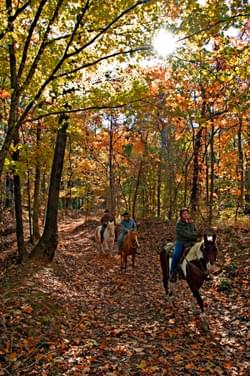




By Dr. Gene Wood
Equestrian trail users are awakening to the fact that we are recreating largely on public lands owned by more than 300 million citizens.

As a fraction of the 1.9 million Americans that own horses, we as trail riders must take stock of our situation. The future will be only as bright as our commitment to articulate, understand, and follow a land ethic. It is crucial for us to be more aware of how we behave on trails, as well as in how we design, build, and maintain trails
On the positive side, I have seen progress in the sensitivity of recreational trail horse users towards environmental protection issues. One example is the cooperative effort of the Back Country Horsemen of America (BCHA) and its Education Foundation to support Leave No Trace training. Those completing this training return to their respective states to teach LNT techniques to their fellow trail horsemen.
The American Horse Council has also created a Recreation Committee that is largely focused on trails issues, and a trail equestrian now serves on the American Trails Board of Directors. We should also mention that in the last 12 months two horse trail books, each of substantial size, have been published. Both are aimed at the creation of recreational horse trails and trail facilities that are user safe and environmentally sound.
Another promising development is the formation of a group that intends to create a national horse trails organization to encompass all types of trail horse use across the national landscape. A key player in this movement is Brian Bourne, Trails Specialist, Shawnee National Forest, who in his lead presentation at the 2008 Southeastern Equestrian Trails Conference, cautioned attendees that when conservation and recreation are in conflict on the public lands, conservation will win. It was a succinct and accurate statement that I hope will guide our efforts in the future.
In seeking to protect our recreation opportunities, we may be ignoring the potential of horse use to damage natural resources. Some pending legislation as well as management plan and rule appeals (e.g. designated trail regulations), and litigation against the Forest Service not only ignore the agency’s mandate for resource protection, they also ignore the proportion (40%) of the National Forest System budget used to deal with such processes.
Again on the positive side, the 1998 National Symposium on Horse Trails in Forest Ecosystems drew 175 participants from 37 states. In addition, out of that symposium grew the Southeastern Equestrian Trails Conference (SETC) and the Ohio Valley Equestrian Trails Symposium (OVETS). The SETC recently met for the ninth consecutive year. It has cycled through 6 southern states and now encompasses 14 member states.
However, we need to remember the original purpose of these conferences. The purpose was documented as creating a forum for informed discussion of the best available science, policy, and user values that can lead to the preservation of a cultural heritage in a natural heritage setting. The concept for the conference is currently represented as “a conference for those interested in building, maintaining, and enjoying equestrian trails.” What happened to the concerns for conservation? How can we find a balance between recreation and conservation?
Despite the progress we have made, as a user group, we still need to articulate and understand a land ethic. As Aldo Leopold wrote, “The road to conservation is paved with good intentions that often prove futile, or even dangerous, due to a lack of understanding of either land [the ecosystem] or economic land use.”
About the Author
Dr. Gene W. Wood is Professor Emeritus, Clemson University Dept. of Forestry and Natural Resources and the author of Recreational Horse Trails in Rural and Wildland Areas: Design, Construction, and Maintenance